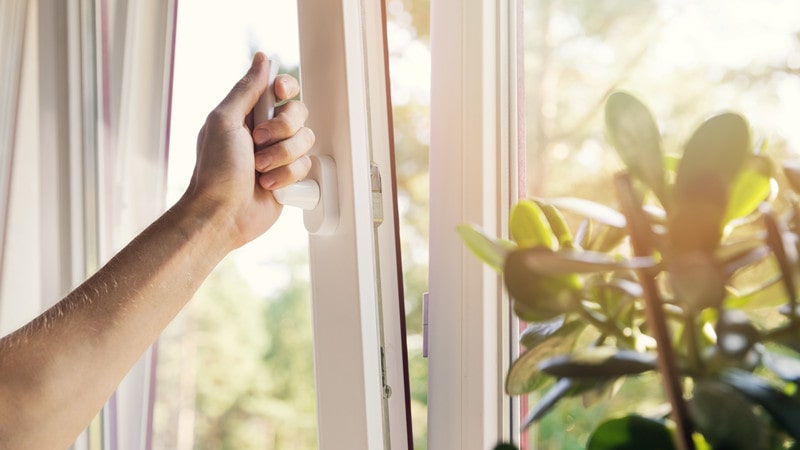Indoor air quality is a crucial factor that significantly impacts a home’s well-being and comfort. Poor ventilation leads to stagnant and stale air, which can result in the accumulation of pollutants and allergens, which may compromise the health and safety of the occupants. Ensuring better home ventilation improves air quality, contributes to a healthier and safer living environment, reduces the risk of respiratory issues, and promotes better sleep quality.
This article offers practical, do-it-yourself (DIY) solutions that can be easily implemented to significantly enhance your home’s ventilation and air quality, such as installing air purifiers, using natural ventilation techniques, and maintaining proper humidity levels. These steps will create a more pleasant and refreshing atmosphere and provide long-term benefits for your and your family’s well-being.
DIY solutions for better home ventilation
Here are some of the most practical DIY solutions that can be implemented to improve home ventilation and air quality:
Install exhaust fans
Exhaust fans are considered one of the most effective methods to enhance indoor air quality. These fans are commonly installed in bathrooms, kitchens, laundry rooms, or other spaces where moisture accumulates. By efficiently extracting the humid air from these areas and expelling it outside, the exhaust fan plays a crucial role in the overall air quality within your home.
Use air-sealing techniques
Air sealing is a critical process that blocks any drafts or leaks in your home’s exterior walls and windows. You can significantly enhance your home’s overall ventilation and air quality by identifying and sealing off these potential moisture and air infiltration sources. It helps maintain a comfortable living environment and promotes energy efficiency by preventing unnecessary heat loss or gain. Take the time to address these areas and ensure a well-sealed and well-ventilated home for a healthier and more sustainable living space.
Replace air filters
Replacing old and dirty air filters is a surefire way to significantly reduce poor indoor air quality. Regularly checking and cleaning these filters can effectively maintain healthy ventilation and optimal air quality levels in your living space. Additionally, it is essential to consider replacing any old or worn-out parts of your HVAC system, such as ducts and vents, as they can be significant sources of pollutants that compromise air quality.
Consider using a professional and experienced HVAC technician to ensure your system runs efficiently, safely, and effectively. For more information on HVAC installers, go to https://envirosmartsolution.com/.
Use natural ventilation techniques.
Natural ventilation, a highly influential and cost-efficient approach, enhances indoor air quality. Cross-ventilation is achieved by strategically opening windows and doors, facilitating fresh outdoor air while expelling stagnant indoor air. This dynamic exchange creates a healthier and more refreshing living environment, promoting overall well-being and comfort.
Maintain proper humidity levels
High humidity levels can increase mold growth, posing an aesthetic and health hazard. Keeping your home’s humidity comfortable is essential for optimal ventilation and air quality. Installing a dehumidifier in areas prone to moisture accumulation can help maintain a healthy humidity level and ensure good air quality.
Use of indoor plants
Indoor plants like English Ivy, Snake Plant, and Boston Fern have significantly enhanced indoor air quality. These remarkable plants possess the ability to absorb and filter various pollutants present in the air, effectively purifying and revitalizing the surrounding environment.
By removing harmful substances and releasing oxygen, these green companions create a cleaner and fresher atmosphere, promoting better health and well-being for those who reside or work indoors.
DIY air purifiers
Although several air purifiers are available, a DIY air purifier can be a practical and cost-effective solution to effectively filter out harmful particles from indoor air. Using basic materials such as a sturdy cardboard box, high-quality cotton batting for enhanced filtration, a high-efficiency air filter, and a reliable fan for optimal air circulation, you can create a customized air purifier that suits your needs. With this DIY approach, you can tailor your air purifier’s size, design, and functionality to ensure maximum efficiency and clean air in your living space.
Regular cleaning and maintenance
Ensuring regular cleaning and maintenance of your living area is another effective DIY solution for enhancing indoor air quality. Dust and dirt accumulation in your home can significantly affect the air quality. Regular vacuuming, especially in high-traffic areas and on soft surfaces such as carpets and upholstery, can substantially reduce the amount of dust and allergens.
Frequently washing bedding and curtains can also contribute to maintaining a clean, dust-free environment in your home, further promoting better ventilation and air quality. Regular HVAC system maintenance can also be crucial in maintaining indoor air quality.
The final word
By implementing these easy-to-follow DIY solutions for better home ventilation and air quality, you can create a healthier and safer living environment for yourself and your family. These solutions are cost-effective, easy to maintain, and will provide long-term benefits for your well-being. Moreover, better air quality increases a home’s value when selling it on the market.
With that in mind, take proactive steps and start implementing these DIY solutions today. Doing so will ensure healthier, fresher air in your home and contribute to a more comfortable living environment.




